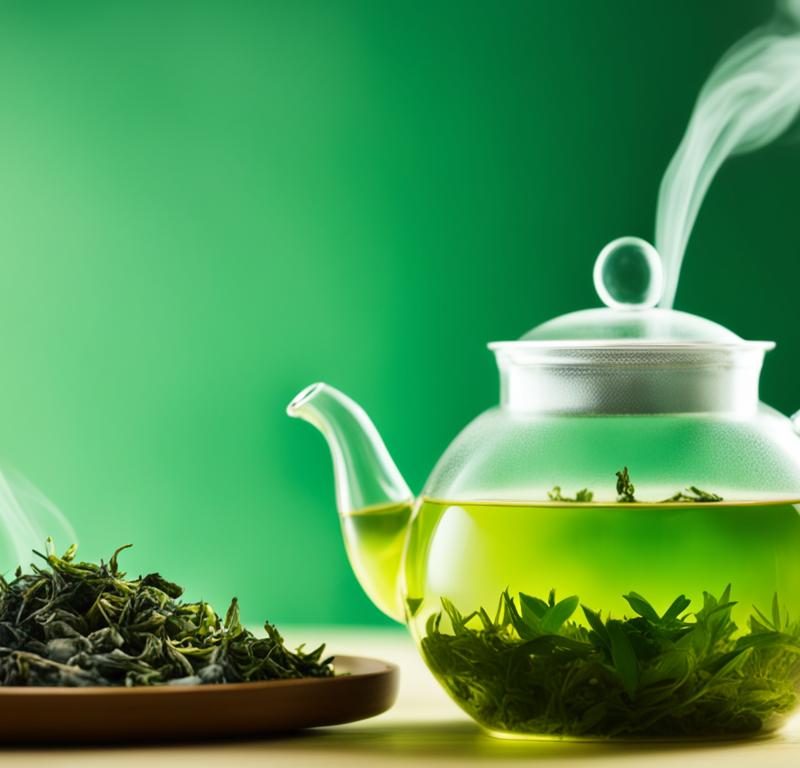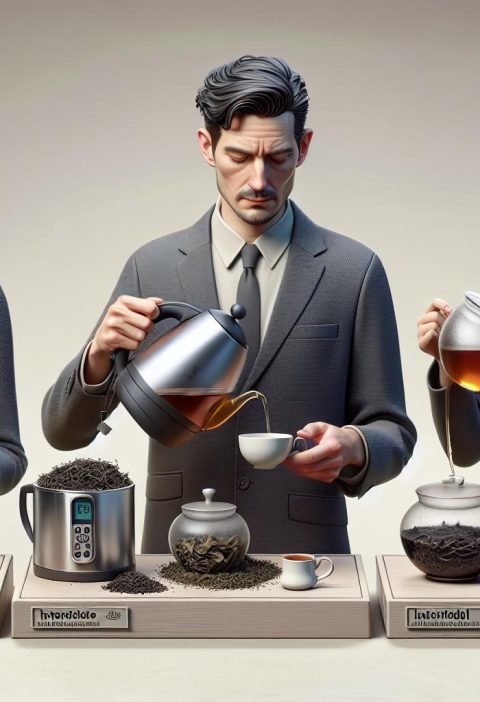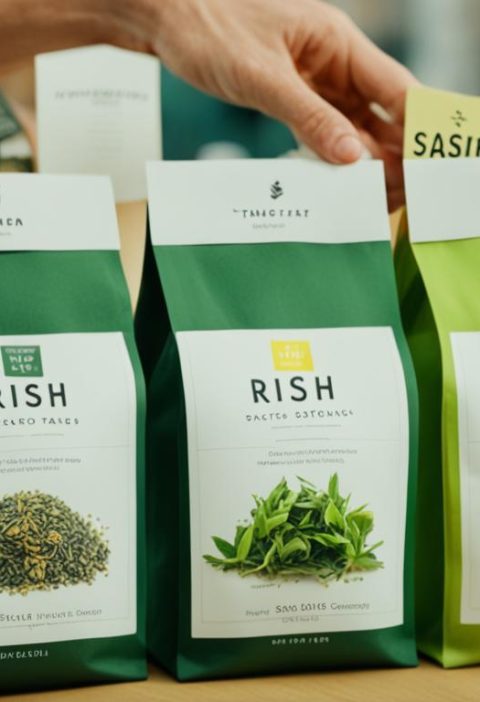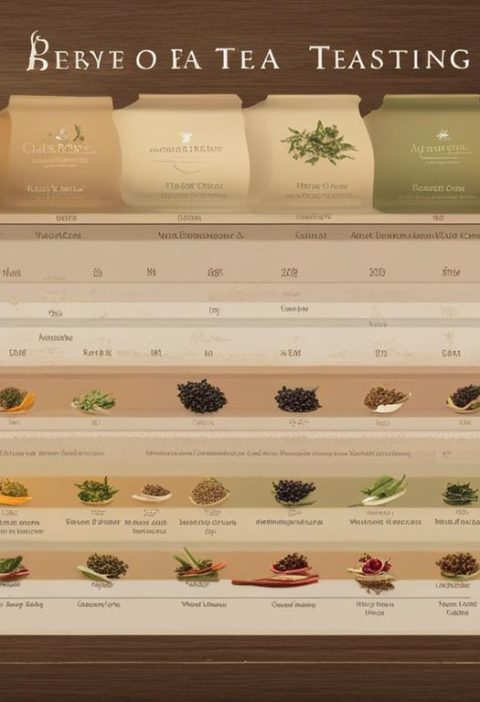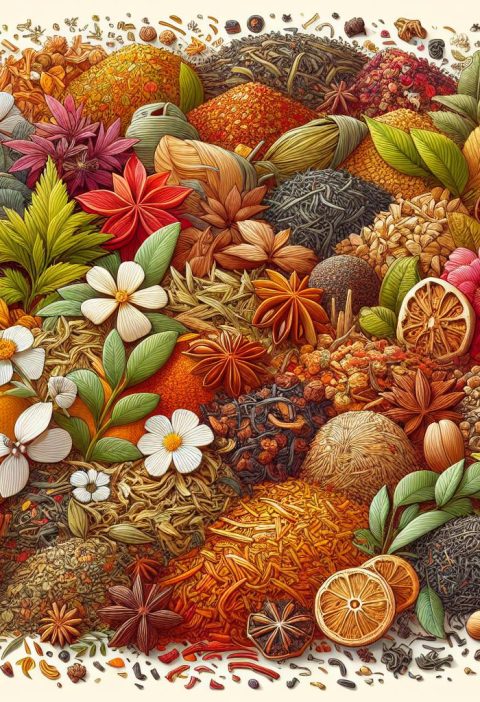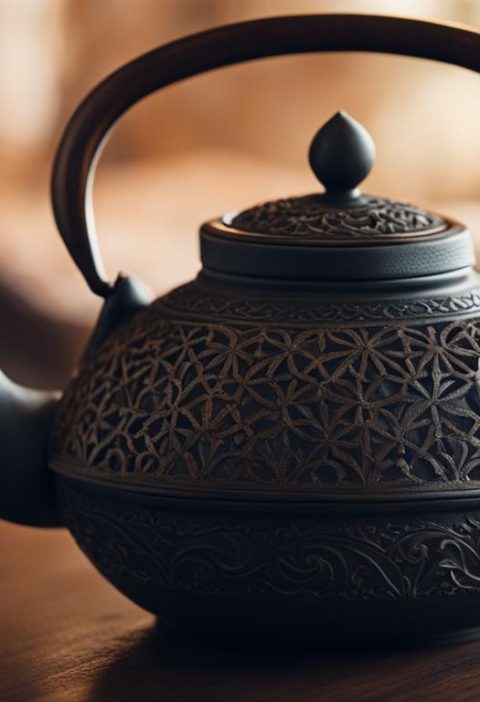Steeping green tea involves finding the perfect balance between releasing the tea’s flavors and avoiding bitterness. But what is the optimal steeping time for green tea? In this article, we will explore the various factors that contribute to the best steeping time for green tea, including the type of tea, water temperature, and personal taste preferences. We will also provide tips and insights to help you achieve the perfect cup of green tea every time.
How Long to Steep Green Tea—General Tips & Tricks
When it comes to steeping green tea, there are some general guidelines you can follow:
- Use a ratio of two grams of loose tea leaves per six-ounce cup of water.
- Steep the tea in water between 158 and 176 degrees Fahrenheit.
- Steep for one to four minutes.
- Adjust steeping time based on personal taste preferences.
Key Takeaways:
- Use a ratio of two grams of loose tea leaves per six-ounce cup of water.
- Steep green tea in water between 158 and 176 degrees Fahrenheit.
- The recommended steeping time for green tea is one to four minutes.
- Adjust the steeping time according to personal taste preferences.
Steeping Time for Loose Vs. Bagged Green Tea
Is there a difference in steeping time between loose green tea and bagged green tea? The answer is yes. Here are the steeping time recommendations for each:
- Bagged green tea: 1-3 minutes.
- Loose green tea: 1-4 minutes.
Keep in mind that quality bagged green teas can still produce great flavors with a shorter steeping time.
Key Takeaways:
- Bagged green tea requires a slightly shorter steeping time than loose tea.
- Steep bagged green tea for 1-3 minutes.
- Steep loose green tea for 1-4 minutes.
Caffeine Content and Steeping Time
Does the steeping time of green tea affect its caffeine content? The answer is yes. Steeping green tea for a longer time can increase the caffeine content in your cup. However, there is a way to reduce the caffeine if desired:
- Double-steep the same leaves by discarding the first infusion after 30 seconds to one minute.
It’s important to note that this method may also reduce the flavor intensity of the tea.
Key Takeaways:
- Longer steeping time can increase the caffeine content of green tea.
- Double-steep green tea to reduce caffeine by discarding the first infusion.
- Be aware that reducing caffeine may also impact flavor intensity.
Health Benefits of Optimal Steeping
Proper steeping techniques can enhance the health benefits of green tea. When steeped optimally, green tea releases antioxidant-containing catechins that have been linked to various health benefits, including:
- Anti-aging properties
- Improved brain function
- Fresh breath
It’s important to avoid over-steeping or using water above 194 degrees Fahrenheit, as this can lower catechin levels and diminish the tea’s health benefits.
Key Takeaways:
- Optimal steeping maximizes the release of antioxidant-containing catechins in green tea.
- Catechins have been linked to anti-aging properties, improved brain function, and fresh breath.
- Over-steeping or using water above 194 degrees Fahrenheit can diminish the health benefits.
How Long to Steep Green Tea—General Tips & Tricks
When it comes to brewing the perfect cup of green tea, steeping time plays a crucial role in achieving the desired flavor and aroma. Here are some general guidelines and tips to help you determine how long to steep your green tea:
- Use the right tea-to-water ratio: For optimum flavor, use a ratio of two grams of loose tea leaves per six-ounce cup of water. Adjust the amount of tea leaves based on your personal preference.
- Get the water temperature right: Steep green tea in water between 158 and 176 degrees Fahrenheit (70-80 degrees Celsius) to ensure proper extraction of flavors. Using water that is too hot can lead to a bitter taste, while water that is too cool may result in a weak infusion.
- Steeping time: The ideal steeping time for green tea is typically one to four minutes. However, this can vary depending on the specific type of green tea and your personal taste preferences. Keep in mind that steeping time affects the strength of the tea, with longer steeping times resulting in a more robust flavor.
- Observe the color: The color of the steeped tea can provide valuable cues about its readiness. Lighter green color indicates a shorter steeping time, while a deeper golden hue suggests a longer steeping time.
Remember, these are general guidelines, and you can adjust them based on your personal taste preferences. Experiment with different steeping times to find the flavor profile that suits you best.
To give you a visual reference, here’s a table summarizing the recommended steeping times for various types of green tea:
| Green Tea Type | Steeping Time |
|---|---|
| Sencha | 2-4 minutes |
| Matcha | Whisk into hot water |
| Genmaicha | 2 minutes |
| Hojicha | 2-4 minutes |
| Longjing | 2-4 minutes |
| Flavored Green Tea | Varies |
Steeping Time for Loose Vs. Bagged Green Tea
When it comes to preparing green tea, the steeping time can vary depending on whether you are using loose tea or bagged tea. The size and quality of the tea leaves can influence the optimal steeping time, ultimately affecting the flavor and aroma of your beverage.
Loose tea, made up of whole tea leaves, typically requires a slightly longer steeping time compared to bagged tea. The larger surface area of loose tea allows for a slower and more complete infusion of flavors.
On the other hand, bagged green tea typically contains smaller tea leaves or fannings, which can lead to a quicker release of flavors. As a result, bagged green tea often requires a shorter steeping time to achieve a well-balanced brew.
To help you determine the ideal steeping time for your green tea, consider the following guidelines:
- Loose Tea: Steep for one to four minutes to extract the full flavors and aromas. Adjust the steeping time based on personal preference and the type of loose tea being used.
- Bagged Tea: Steep for one to three minutes to achieve a flavorful cup. Quality bagged green teas can deliver excellent taste even with a shorter steeping time.
Keep in mind that these steeping times are general recommendations. You may need to experiment and adjust the duration based on your individual taste preferences. It’s also worth considering the water temperature and tea-to-water ratio, as these factors can impact the brewing process.
| Green Tea Type | Steeping Time for Loose Tea (minutes) | Steeping Time for Bagged Tea (minutes) |
|---|---|---|
| Sencha | 2-3 | 1-2 |
| Dragon Well (Longjing) | 2-4 | 1-3 |
| Gunpowder | 2-3 | 1-2 |
| Jasmine Green Tea | 2-3 | 1-2 |
Table: Recommended steeping times for loose tea and bagged tea for selected green tea varieties.
Remember that the steeping time plays a crucial role in bringing out the best flavors from your green tea. Whether you choose loose tea or bagged tea, be sure to experiment, adjust, and find the perfect steeping time that suits your taste preferences and brings out the desired flavors and aromas in your green tea.
Caffeine Content and Steeping Time
When it comes to green tea, caffeine content and steeping time are crucial factors to consider. Green tea naturally contains caffeine, which can vary in amount depending on various factors such as tea type and steeping duration. Understanding the relationship between green tea’s caffeine content and steeping time can help you tailor your tea-drinking experience to your desired caffeine level.
On average, green tea contains about 20-50 milligrams of caffeine per cup. However, the precise caffeine content may change based on factors such as tea quality, leaf size, and steeping time. Longer steeping times tend to result in higher caffeine levels, as the tea leaves have more time to release the caffeine compounds into the water.
If you are looking to reduce the caffeine content in your green tea, double-steeping the same leaves is an effective technique. This involves discarding the first infusion after a short steeping time of 30 seconds to one minute. By doing so, a considerable portion of the caffeine is removed, resulting in a milder cup of tea. It’s important to note that double-steeping may also reduce the flavor intensity. So, if you prefer a bolder taste, a single steep with a shorter duration is recommended.
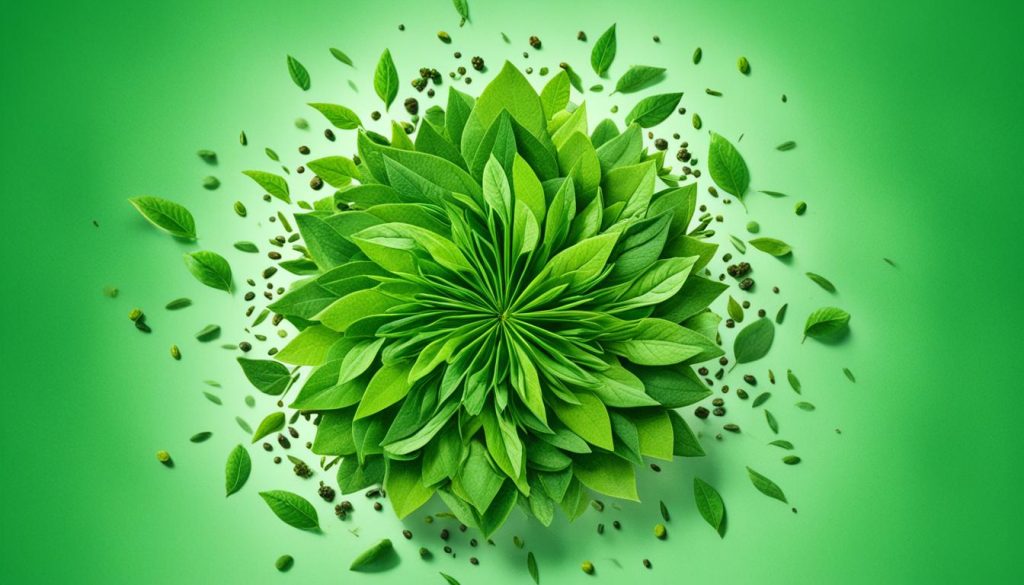
Caffeine Content Comparison
| Steeping Time | Caffeine Content |
|---|---|
| 1 minute | Reduced caffeine content |
| 2 minutes | Moderate caffeine content |
| 3 minutes | Higher caffeine content |
| 4 minutes+ | Significantly higher caffeine content |
Experimenting with steeping times and techniques will help you discover the perfect balance between caffeine content and flavor intensity. Keep in mind that everyone’s caffeine tolerance and preference vary, so don’t be afraid to adjust the steeping time to suit your personal taste.
Health Benefits of Optimal Steeping
Proper steeping of green tea maximizes its health benefits by enhancing the release of antioxidant-containing catechins. These powerful compounds have been associated with various health advantages, including anti-aging properties, improved brain function, and fresh breath. By understanding the optimal steeping methods, you can unlock the full potential of green tea and enjoy its many health benefits.
When green tea is steeped correctly, catechins are released into the infusion, providing a range of health advantages. Studies suggest that catechins act as powerful antioxidants, helping to protect cells from damage caused by harmful free radicals. Antioxidants play a crucial role in maintaining overall health and well-being.
Additionally, the catechins present in green tea have been linked to anti-aging effects. These compounds may help fight signs of aging by reducing oxidative stress and promoting youthful skin. Green tea’s antioxidant properties can also support cardiovascular health and lower the risk of heart disease.
Furthermore, incorporating green tea into your daily routine can have positive effects on brain function. Catechins may improve cognitive performance, memory, and focus. Regular consumption of green tea has even been associated with a reduced risk of neurodegenerative diseases such as Alzheimer’s and Parkinson’s.
It is important to note that steeping green tea for too long or using excessively hot water can diminish the health benefits. Over-steeping or using water above 194 degrees Fahrenheit may lead to decreased catechin levels and a bitter taste. To optimize the health benefits of green tea, it is recommended to follow the proper steeping techniques outlined in this article.
To summarize, optimal steeping of green tea enhances its health benefits by maximizing the release of catechins. These powerful antioxidants have been linked to anti-aging effects, improved brain function, and fresh breath. By steeping green tea correctly, you can enjoy its numerous health advantages and savor a delicious and beneficial cup of tea.
| Health Benefits of Green Tea | Optimal Steeping Techniques |
|---|---|
| Antioxidant properties | Steep green tea for the recommended time and temperature to maximize catechin release |
| Anti-aging effects | Avoid over-steeping or using water above 194 degrees Fahrenheit to prevent catechin degradation |
| Improved brain function | Follow proper green tea steeping methods to ensure optimal catechin levels for cognitive benefits |
| Fresh breath | Optimize steeping time to extract catechins that contribute to fresh breath |
History and Cultivation of Green Tea
Green tea has a long and fascinating history that traces back to 200 B.C.E. It is considered one of the five “true” teas, along with black, oolong, white, and pu-erh tea, all derived from the leaves of the Camellia sinensis plant. However, it is green tea that sets itself apart with its unique flavor, aroma, and health benefits.
The cultivation and production of green tea have deep cultural roots in East Asia, particularly in China and Japan. These regions have perfected the art of growing, harvesting, and processing green tea for centuries. The process begins with carefully selecting the right tea cultivars and growing them in optimal conditions.
Green tea cultivation requires a specific climate and environment. It thrives in regions with temperate to subtropical climates, with ample rainfall and well-draining soil. East Asia offers the perfect conditions for green tea cultivation, with China and Japan being the primary producers of this sought-after beverage.
Once the tea plants have matured, the leaves are harvested by hand or machine, depending on the desired quality. In some cases, only the young and tender leaves are plucked for higher-grade teas, while others may include more mature leaves.
After harvesting, a crucial step in the production of green tea is the handling and processing of the leaves. Traditionally, green tea leaves are quickly heated, either through steaming or pan-firing, to halt oxidation. This step helps retain the natural green color and fresh taste of the leaves.
Next, the leaves undergo rolling, which helps shape the leaves, release their aromatic compounds, and alter their internal cellular structure. This process can be done by hand or using special machinery, depending on the scale of production.
Finally, the leaves are dried to remove any remaining moisture and ensure long-term shelf stability. This can be done through various methods, such as sun-drying, oven-drying, or using specialized drying machines.
This image depicts the lush green tea fields and meticulous cultivation techniques practiced in East Asia.
The careful combination of these cultivation and processing methods results in the diverse and intricate flavors found in different varieties of green tea. From the delicate and grassy flavors of Japanese sencha to the nutty and roasted notes of Chinese longjing, each variety offers a unique taste experience.
| Green Tea Variety | Origin | Flavor Profile |
|---|---|---|
| Sencha | Japan | Grassy, vegetal |
| Matcha | Japan | Rich, umami |
| Longjing (Dragon Well) | China | Nutty, chestnut |
| Biluochun | China | Floral, fruity |
The rich history and intricate cultivation techniques behind green tea contribute to its enduring popularity and widespread consumption. By understanding the lineage of green tea and the careful steps taken to produce it, we can fully appreciate the flavors, aromas, and health benefits that each cup of green tea offers.
Types of Green Tea and Steeping Recommendations
When it comes to green tea, there are several types available, each with its own unique flavor profile and recommended steeping time. Whether you prefer the classic taste of Japanese green tea or the roasted notes of Chinese varieties, finding the right steeping time is essential to unlock the full potential of these teas.
1. Sencha
Sencha is a popular Japanese green tea known for its grassy and slightly sweet flavor. To steep sencha, follow these recommendations:
- Water temperature: 170-176 degrees Fahrenheit
- Steeping time: 2-4 minutes
2. Genmaicha
Genmaicha is a unique Japanese blend of green tea and roasted rice, offering a nutty and toasty flavor. Steep genmaicha using the following guidelines:
- Water temperature: 175-185 degrees Fahrenheit
- Steeping time: 2 minutes
3. Hojicha
Hojicha is a roasted Japanese green tea that boasts a mellow and smoky taste. Here are the steeping recommendations for hojicha:
- Water temperature: 175 degrees Fahrenheit
- Steeping time: 2-4 minutes
4. Longjing
Longjing, also known as Dragon Well, is a popular Chinese green tea with a refreshing and slightly nutty flavor. Steep Longjing using the following recommendations:
- Water temperature: 165-176 degrees Fahrenheit
- Steeping time: 2-4 minutes
For flavored green teas, steeping time may vary depending on the specific blend and added ingredients. It’s best to refer to the instructions provided by the tea manufacturer to achieve the desired flavor balance.
Additionally, matcha, a powdered green tea used in traditional Japanese tea ceremonies, is not steeped like loose-leaf teas. Instead, it is whisked into hot water until frothy, creating a vibrant and full-bodied cup of tea.
Discovering the ideal steeping time for each type of green tea will ensure that you enjoy the complex flavors and unique characteristics of each brew. Experimenting with different steeping times and water temperatures can help you find your perfect cup of green tea.
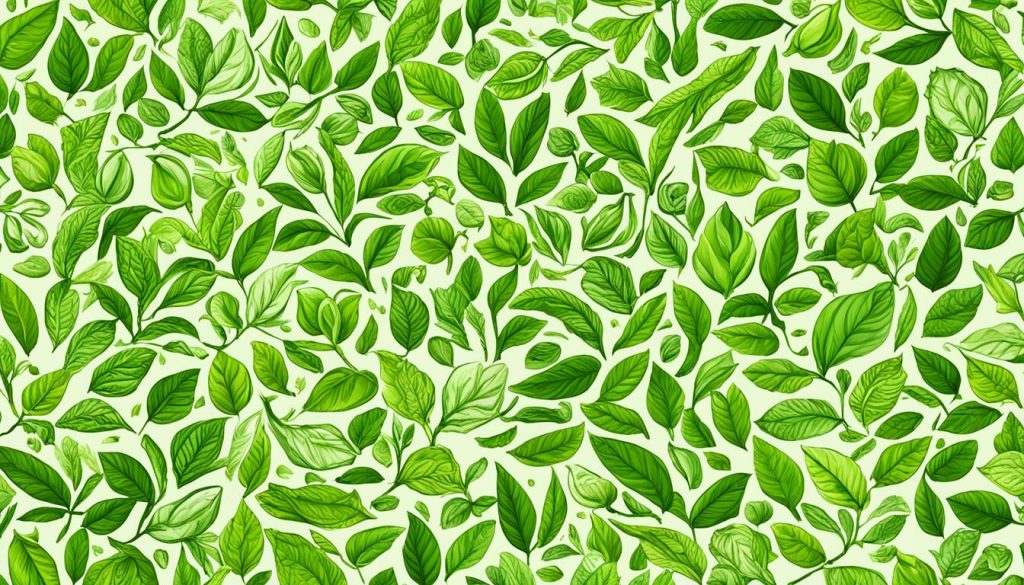
Please note that the image does not display correctly in this text-based interface. The actual placement should be in the center of the section, visually appealing and relevant to the topic.
Steeping Time for Second and Subsequent Infusions
When it comes to green tea, the journey doesn’t end after the first infusion. In fact, many green tea enthusiasts enjoy multiple steepings from the same tea leaves to explore different flavors and aromas that emerge with each infusion. So, how do you determine the steeping time for these subsequent infusions? Let’s explore.
Generally, the steeping time for second and subsequent infusions of green tea is shorter than the initial infusion. As the tea leaves have already released a significant portion of their flavor compounds in the first steeping, subsequent infusions require less time to achieve a balanced and enjoyable cup of tea.
A rule of thumb is to reduce the steeping time by about half for each subsequent infusion. For example, if you steeped your green tea for two minutes in the first infusion, the second infusion should be around one minute.
However, it’s important to note that the exact steeping time can vary depending on factors such as tea type, leaf quality, and personal taste preferences. Some green teas may benefit from a slightly longer or shorter steeping time in the second or third infusion to bring out their unique characteristics.
To help you navigate the world of multiple steepings, here’s a handy table that provides a general guideline for steeping times in subsequent infusions:
| Infusion | Steeping Time |
|---|---|
| Second | About half of the initial infusion time |
| Third | About half of the second infusion time |
| Subsequent Infusions | Adjust based on personal preference |
Keep in mind that these are general guidelines, and you may find that certain green teas require shorter or longer steeping times for subsequent infusions to achieve the desired flavor profile. Feel free to experiment and adjust the steeping time to suit your taste.
By exploring multiple steepings, you can unlock a whole new world of flavors and aromas in your green tea, creating a truly immersive tea-drinking experience.
So, step into the realm of second and subsequent infusions and savor all the nuances that your green tea has to offer. Happy steeping!
Cold Brewing Green Tea
If you’re looking for a refreshing twist to your green tea experience, consider cold brewing. Also known as the mizudashi method, this alternative steeping technique involves using cold or room temperature water to create a unique and revitalizing brew. Cold brewing green tea results in a smoother and sweeter flavor profile, ideal for hot summer days or when you crave a cool and refreshing beverage.
The process of cold brewing is simple. Start by combining loose green tea leaves with cold or room temperature water in a container. The ratio is typically one teaspoon of tea leaves to one cup of water, but you can adjust according to your preference. Stir gently to ensure the leaves are soaked properly. Then, let the mixture steep in the refrigerator for about three hours. This extended steeping time allows the flavors to infuse gently into the water, resulting in a lighter but still flavorful cup of green tea.
One of the advantages of cold brewing is that it reduces the bitterness that can sometimes be present in traditionally brewed green tea. This method allows for a milder and less astringent flavor. The resulting cold brew is also less acidic, making it easier on the stomach. Feel free to experiment with steeping times to find your preferred strength and taste. After steeping, strain the brew to remove the tea leaves and enjoy your chilled cup of cold brew green tea.
So, next time you want to try something different with your green tea, give cold brewing a shot. The mizudashi method is a great way to enjoy the refreshing flavors of green tea in a cool and soothing form.
